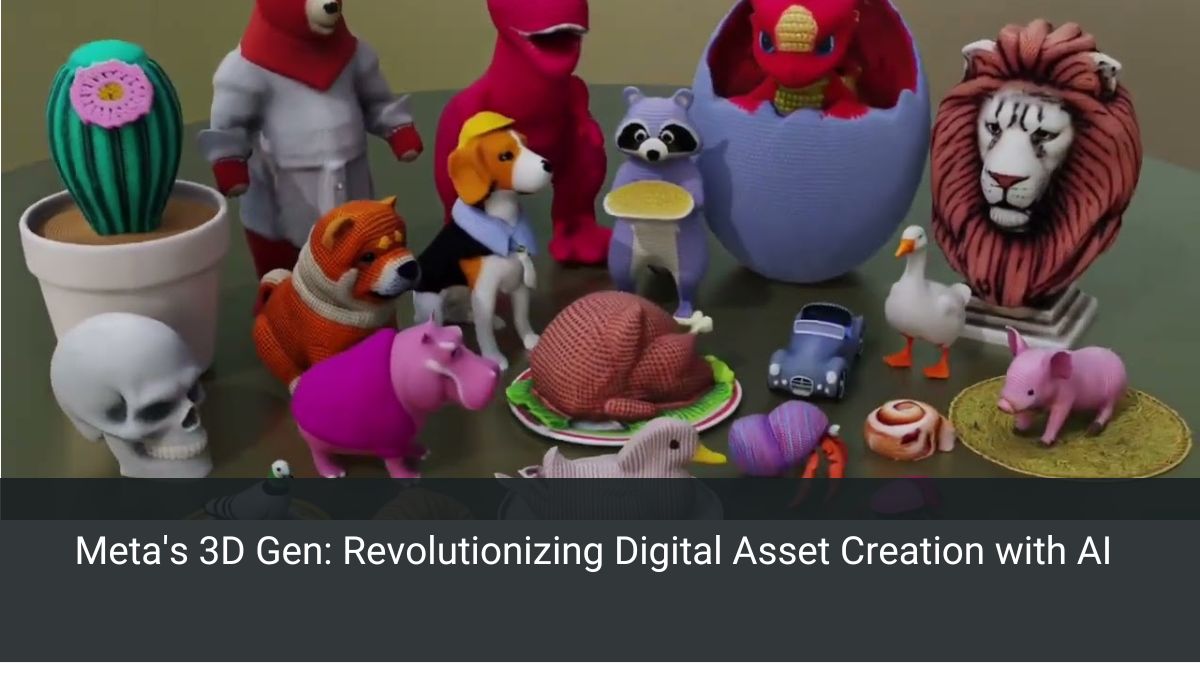AI
Meta’s 3D Gen: Revolutionizing Digital Asset Creation with AI

The Dawn of a New Era in 3D Modeling
In the ever-evolving landscape of technology, Meta has once again pushed the boundaries of what’s possible. Their latest innovation, Meta 3D Gen, is set to transform the way we create and interact with digital assets. As someone who’s been tinkering with 3D modeling software for years, I can’t help but feel a mix of excitement and trepidation about this groundbreaking development.
Unpacking Meta 3D Gen: A Game-Changer in the Making
Meta 3D Gen is not just another incremental improvement in 3D asset creation. It’s a quantum leap. This AI-powered system can conjure up high-quality 3D assets from mere text descriptions in under a minute. Let that sink in for a moment. What used to take hours, if not days, can now be accomplished in less time than it takes to brew a cup of coffee.
The system comprises two key components:
- Meta 3D AssetGen: Creates 3D meshes
- Meta 3D TextureGen: Generates textures
Together, these technologies produce 3D assets with high-resolution textures and physically based rendering (PBR) materials. It’s like having a digital sculptor and painter working in perfect harmony at superhuman speeds.
Breaking Down the Magic: How Meta 3D Gen Works
Speed Meets Quality
Meta claims that their new system is three to ten times faster than existing solutions. This isn’t just about speed, though. The quality of the output is equally impressive. As the researchers state in their paper, “3DGen offers 3D asset creation with high prompt fidelity and high-quality 3D shapes and textures in under a minute.”
I remember spending countless hours tweaking vertices and UV maps to get textures just right. The thought of achieving similar or better results in a fraction of the time is mind-boggling.
The PBR Revolution
One of the most exciting aspects of Meta 3D Gen is its support for physically based rendering (PBR) materials. This feature allows for realistic relighting of generated 3D objects, a crucial capability for integrating AI-generated assets into real-world applications and existing 3D pipelines.
Imagine creating a 3D model of a medieval sword and being able to see how it would look in various lighting conditions – from a dimly lit castle to the glaring sun of a battlefield – all without manual adjustments. This level of flexibility could be a game-changer for industries ranging from video game development to architectural visualization.
Texture Generation: The Devil’s in the Details
Meta 3D TextureGen, the system’s texture generation component, can create high-quality and globally consistent textures for complex 3D geometries in less than 20 seconds. But it doesn’t stop there. It also includes a texture enhancement network capable of upscaling textures to 4K resolution.
As someone who’s spent hours hand-painting textures, the idea of generating and upscaling them in seconds is both thrilling and slightly unsettling. It’s like watching a magic trick – you know there’s a logical explanation, but it still feels like sorcery.
The Ripple Effect: Industries on the Brink of Transformation
Gaming: Leveling Up Development
For the gaming industry, Meta 3D Gen could be nothing short of revolutionary. Rapid prototyping and iteration of environments and assets could dramatically speed up development cycles. I can already imagine game designers creating entire worlds with a few well-crafted prompts.
Architecture and Industrial Design: From Concept to Visualization in Minutes
In fields like architecture and industrial design, quick visualization of concepts is crucial. Meta 3D Gen could enable architects and designers to bring their ideas to life in record time, improving communication with clients and streamlining the design process.
AR and VR: Building Immersive Worlds
The implications for augmented and virtual reality are equally profound. By lowering the barriers to creating high-quality 3D assets, Meta 3D Gen could accelerate the development of immersive experiences for education, training, and entertainment.
The Human Element: Creativity in the Age of AI
While the capabilities of Meta 3D Gen are undoubtedly impressive, they also raise questions about the future of 3D modeling as a profession. As someone who’s invested countless hours honing my 3D modeling skills, I can’t help but wonder: Will AI replace human 3D artists?
The answer, I believe, is more nuanced than a simple yes or no. While Meta 3D Gen is likely to enhance the productivity of 3D artists, it may also shift the focus of the profession. Instead of spending hours on routine asset creation, artists may find themselves taking on more of a creative director role, focusing on complex, custom work that AI still struggles to replicate.
The Future of Digital Creation
As we stand on the brink of this new era in 3D asset creation, it’s natural to feel a mix of excitement and apprehension. Meta 3D Gen represents a significant milestone in the ongoing AI revolution, with the potential to democratize 3D content creation and accelerate innovation across multiple industries.
However, as with any transformative technology, it’s crucial that we approach it thoughtfully. We must consider not only its capabilities but also its implications for creative professionals and the broader digital ecosystem.
Embracing the Future
As we move forward, I encourage all of us in the creative and tech communities to engage with this technology actively. Experiment with it, push its boundaries, and most importantly, think critically about how we can harness its power responsibly.
What new possibilities does Meta 3D Gen open up for your work or hobby? How do you envision the role of human creativity evolving alongside AI? These are questions we must grapple with as we step into this brave new world of AI-assisted creation.
In the end, Meta 3D Gen is not just a tool; it’s a catalyst for reimagining what’s possible in the digital realm. Let’s embrace this opportunity to push the boundaries of our creativity and innovation. The future of 3D asset creation is here, and it’s up to us to shape it.
